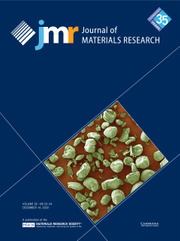Crossref Citations
This article has been cited by the following publications. This list is generated based on data provided by
Crossref.
Li, Xiaodong
and
Bhushan, Bharat
1999.
Evaluation of fracture toughness of ultra-thin amorphous carbon coatings deposited by different deposition techniques.
Thin Solid Films,
Vol. 355-356,
Issue. ,
p.
330.
Bhushan, Bharat
1999.
Chemical, mechanical and tribological characterization of ultra-thin and hard amorphous carbon coatings as thin as 3.5 nm: recent developments.
Diamond and Related Materials,
Vol. 8,
Issue. 11,
p.
1985.
Gonella, F.
Mattei, G.
Mazzoldi, P.
Sada, C.
Battaglin, G.
and
Cattaruzza, E.
1999.
Au–Cu alloy nanoclusters in silica formed by ion implantation and annealing in reducing or oxidizing atmosphere.
Applied Physics Letters,
Vol. 75,
Issue. 1,
p.
55.
Scott, William W
and
Bhushan, Bharat
2000.
Corrosion and wear studies of uncoated and ultra-thin DLC coated magnetic tape-write heads and magnetic tapes.
Wear,
Vol. 243,
Issue. 1-2,
p.
31.
Richter, Asta
Ries, Ronald
Smith, Roger
Henkel, Matthias
and
Wolf, Bodo
2000.
Nanoindentation of diamond, graphite and fullerene films.
Diamond and Related Materials,
Vol. 9,
Issue. 2,
p.
170.
Scott, William W.
Bhushan, Bharat
and
Lakshmikumaran, Anand V.
2000.
Ultrathin diamond-like carbon coatings used for reduction of pole tip recession in magnetic tape heads.
Journal of Applied Physics,
Vol. 87,
Issue. 9,
p.
6182.
Roberts, C. Chad
Orthion, Pascal J.
Hassel, April E.
Parrish, Bryan K.
Buckley, Steven R.
Fearon, Evelyn
Letts, Stephan A.
and
Cook, Robert C.
2000.
Development of Polyimide Ablators for NIF: Analysis of Defects on Shells, a Novel Smoothing Technique and Upilex Coatings.
Fusion Technology,
Vol. 38,
Issue. 1,
p.
94.
Wu, Mei-Ling
Howard, Kent
Grannen, Kevin
Gui, Jing
Rauch, Gary C
and
Sides, Paul J
2000.
Properties and durability of thin a-C:H overcoats produced by plasma enhanced chemical vapor deposition.
Thin Solid Films,
Vol. 377-378,
Issue. ,
p.
249.
Li, Xiaodong
and
Bhushan, Bharat
2001.
Micro/nanomechanical and tribological studies of bulk and thin-film materials used in magnetic recording heads.
Thin Solid Films,
Vol. 398-399,
Issue. ,
p.
313.
Amelio, S.
Goldade, A.V.
Rabe, U.
Scherer, V.
Bhushan, B.
and
Arnold, W.
2001.
Measurements of elastic properties of ultra-thin diamond-like carbon coatings using atomic force acoustic microscopy.
Thin Solid Films,
Vol. 392,
Issue. 1,
p.
75.
Sundararajan, Sriram
and
Bhushan, Bharat
2001.
Development of a continuous microscratch technique in an atomic force microscope and its application to study scratch resistance of ultrathin hard amorphous carbon coatings.
Journal of Materials Research,
Vol. 16,
Issue. 2,
p.
437.
Anders, André
and
Kulkarni, Ashok V.
2001.
Synthesis of Ultrathin Ta-C Films by Twist-Filtered Cathodic Arc Carbon Plasmas.
MRS Proceedings,
Vol. 675,
Issue. ,
Anders, A.
Fong, W.
Kulkarni, A.V.
Ryan, F.W.
and
Bhatia, C.S.
2001.
Ultrathin diamond-like carbon films deposited by filtered carbon vacuum arcs.
IEEE Transactions on Plasma Science,
Vol. 29,
Issue. 5,
p.
768.
Habelitz, Stefan
Marshall, Sally J.
Marshall, Grayson W.
and
Balooch, Mehdi
2001.
The Functional Width of the Dentino-Enamel Junction Determined by AFM-Based Nanoscratching.
Journal of Structural Biology,
Vol. 135,
Issue. 3,
p.
294.
Li, Xiaodong
and
Bhushan, Bharat
2002.
Development of a nanoscale fatigue measurement technique and its application to ultrathin amorphous carbon coatings.
Scripta Materialia,
Vol. 47,
Issue. 7,
p.
473.
Li, Xiaodong
and
Bhushan, Bharat
2002.
A review of nanoindentation continuous stiffness measurement technique and its applications.
Materials Characterization,
Vol. 48,
Issue. 1,
p.
11.
Mishra, B.
Zhou, J.
and
Kustas, F.
2002.
Surface Engineering.
p.
249.
Rau, Kaustubh
Singh, Rajeev
and
Goldberg, Eugene
2002.
Nanoindentation and nanoscratch measurements on silicone thin films synthesized by pulsed laser ablation deposition (PLAD).
Materials Research Innovations,
Vol. 5,
Issue. 3-4,
p.
151.
Huang, Li-Ye
Xu, Ke-Wei
and
Lu, Jian
2002.
Evaluation of scratch resistance of diamond-like carbon films on Ti alloy substrate by nano-scratch technique.
Diamond and Related Materials,
Vol. 11,
Issue. 8,
p.
1505.
Huang, Li-Ye
Xu, Ke-Wei
Lu, Jian
and
Guelorget, Bruno
2002.
Analysis of nano-scratch behavior of diamond-like carbon films.
Surface and Coatings Technology,
Vol. 154,
Issue. 2-3,
p.
232.

